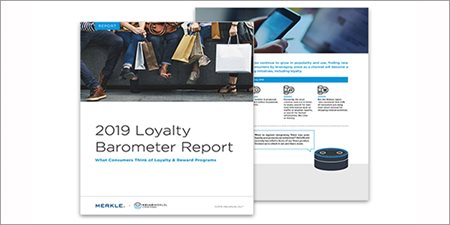Loyalty Report Shows Consumer Sentiment Toward Rewards
How do you keep your customers coming back? Loyalty.
Loyalty programs are an excellent way for brands to create a relationship with their customers and to keep them subscribing or purchasing over and over again. I came across a thought-provoking report entitled: 2019 Loyalty Barometer Report – HelloWorld which not only dives into consumers’ true feelings about reward programs but also sheds light on how brands may need to pivot to accommodate consumer preferences.

To give a bit of context about the report, HelloWorld, a Merkle Company, is a digital marketing solutions provider who works with some of the world’s leading brands across many types of industry verticals. You may actually recognize a few—if not all—of these brands; Samsung, PayPal, Microsoft, Starbucks—to name a few. HelloWorld surveyed over 1,500 male and female consumers in 2018, with responses from U.S. residents between the ages of 18-65. The segmented data was collected by various generations such as Baby Boomers, Gen X, Millennials, and Gen Y.
I was able to connect with Michela Baxter, Senior Director, Loyalty, HelloWorld, A Merkle Company, to have a more in-depth discussion as to how brands can boost their loyalty program offering.
How to Boost Your Loyalty Offering
In the report, 61% of consumers said surprising them with an offer, or gift, was the most important way a brand could interact with them. It was noted that brands need to make sure that consumers can “balance time to earn with ease of redemption so that consumers are motivated and truly rewarded by the program.” I asked Michela what some of these tactics would be in order to help brands boost their loyalty program offering.
“One of the best tactics to boost a company’s loyalty offering is to include a combination of high-value rewards and chance-to-win rewards. High-value gift cards, electronics, trips, and experiences are the types of prizes that not only motivate program members but also add aspirational rewards to the mix; however, many programs struggle with the financial sustainability of including all high value (often high cost) rewards in their offering. Plus, from a consumer perspective, these types of rewards can take too long to earn. Adding chance-to-win rewards, like sweepstakes and instant win games, is an incredibly effective and motivating tactic that brands can use to boost their program offering. Brands that aren’t ready to permanently add sweepstakes or instant win games to their loyalty offering can test these tactics by pulsing in short-term promotional overlays to their existing loyalty program.”
It was no surprise that websites were at the top of the list as the most preferred way consumers accessed their loyalty program, and there was a growing interest in emerging channels such as smart speakers and Facebook messenger. Even Statistics forecasted that in 2022, 66.3 million U.S. households would own a smart-speaker, so this tells me that we definitely could see this as a rising trend.
I’m always intrigued to know more about how brands integrate voice into their business strategy, so I asked Michela her thoughts on exactly how brands use loyalty program information through the use of smart speakers— like Google Home, or Amazon Alexa, etc.—to access loyalty information, especially with the increase in demand.
“Most current loyalty programs that integrate voice allow members to only access basic account details (such as the number of points available), however, by leveraging the strong consumer adoption of smart speakers over the past few years, a loyalty program can provide much more content and many more earning opportunities to its members. For instance, a member could ask questions about a recent promotion, get access to FAQs, or review what rewards are available. Websites allow for increased customization, but accessing the loyalty program using a smart speaker allows the member to a) have a 1:1 conversation with the brand, and b) experience the flexibility to engage and gather information without having a mobile device or computer nearby.”
Mobile App Convenience
Mobile app downloads have been increasing steadily. Statistics show that in 2017 there were 178 billion apps downloaded, with that number projected to grow up to 258 billion in 2022—that’s a whopping 45 percent increase over five years.
The report also mentioned that “App usage accounts for over 90% of internet time on smartphones and 77% of internet time on tablets. Consumers’ desire for accessing loyalty program information via mobile apps relates back to convenience.”
This flourishing app usage instantly makes me think of Amazon Prime. Why? Because they bring enough value to their consumers, who are frequent shoppers such as free, same-day delivery for Amazon Prime members among other perks. Their ease of use and flexibility has customers wanting more. It’s reported that Prime members spend an average of US$1,500 per year on Amazon.com, compared with US$625 per year paid by Amazon customers who aren't Prime members.
I asked Michela what some other reasons why consumers access their program information via mobile apps are.“Consumers use a mobile app because of the utility it provides, which results in it being their preferred channel. Accessing loyalty information is secondary. In other words, they go to the app for other functional reasons (like to use a mobile wallet or place an order) and, because they built this habit over time, they use the app to access program information, redeem a reward, etc.”
Ending Notes
The GDPR making an appearance in 2016 has significantly heightened awareness of the use of data. Consumers in the report said they are not comfortable sharing more “personal” information when it comes to the rewards experience in order to create relevancy. To finish, I asked Michela what her thoughts were on data security and how consumers can rebuild that trust.
“Multiple high-visibility data breaches, like those that Equifax and Facebook/Cambridge Analytica experienced, have created waves of distrust around corporations and data collection, and have shaped how consumers feel about sharing personal information. Consumer expectations are constantly shifting and, while there is a strong desire to be recognized through more personal brand interactions, the need for data transparency (in terms of how consumer information is being used, as well as data security and processes to mitigate breaches) is critical to rebuilding consumer trust.”
All in all, when it comes to redeeming rewards, the unexpected incentives can help consumers feel valued by their favorite brands, fostering stronger emotional connections. Wouldn’t you agree?

Gabriella Pirrone
Gabriella is the Digital Marketing Assistant for CMSC Media. She brings a wealth of knowledge from not only a CMS perspective but also content, SEO and eCommerce. She enjoys everything social media and staying ontop of the latest trends in the digital marketing world.